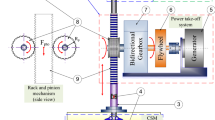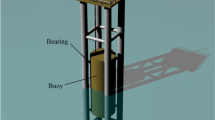Abstract
To reduce environmental pollution, alternative renewable energy resources have been explored for decades. Wave energy has a high energy density, high utilization time and no fuel costs, so it is considered as the most promising alternative to the fossil fuel resources. The number of studies of wave energy converters (WECs) has rapidly increased. This paper proposes a new method to achieve the resonant behavior of a point absorber floating buoy type of WEC using a mechanical power take-off system. By using the inertia characteristics of a hydraulic flywheel accumulator-based electro-hydraulic actuator to change the corresponding supplementary mass of the floating buoy, the total mass of the buoy was close to a match with the relatively low frequency of the wave, so that the buoy was in resonance with the wave. The specifications of the hydraulic flywheel accumulator system were proposed and studied. The working principle was analyzed, and a mathematical model was then derived to investigate the system operation. An experimental set-up was implemented to validate the mathematical model. Numerical simulation using MATLAB/Simulink was done to evaluate the operation of the system.














Similar content being viewed by others
References
Yang, S. M., Ji, H. S., Shim, D. S., Baek, J. H., & Park, S. H. (2017). Conical roll-twist-bending process for fabrication of metallic archimedes spiral blade used in small wind power generator. International Journal of Precision Engineering and Manufacturing—Green Technology, 4, 431–439.
Garate, J., Solovitz, S. A., & Kim, D. (2018). Fabrication and performance of segmented thermoplastic composite wind turbine blades. International Journal of Precision Engineering and Manufacturing—Green Technology, 5, 271–277.
Kim, Y. W., Park, J. H., Lee, N. K., & Yoon, J. H. (2017). Profile design of loop-type blade for small wind turbine. International Journal of Precision Engineering and Manufacturing—Green Technology, 4, 387–392.
Jahangiri, M., & Shamsabadi, A. A. (2017). Designing a horizontal-axis wind turbine for South Khorasan Province: A case study. International Journal of Precision Engineering and Manufacturing—Green Technology, 18, 1463–1473.
Kang, J. H., & Lee, H. W. (2017). Study on the design parameters of a low speed coupling of a wind turbine. International Journal of Precision Engineering and Manufacturing—Green Technology, 18, 721–727.
Cruz, J. (2010). Ocean wave energy, current status and future perspectives. Berlin: Springer.
Falcão, A. F. O. (2010). Wave energy utilization: A review of the technologies. Renewable and Sustainable Energy Reviews, 14, 899–918.
Iraide, L., Jon, A., Salvador, C., de Iñigo Martínez, A., & Iñigo, K. (2013). Review of wave energy technologies and the necessary power-equipment. Renewable and Sustainable Energy Reviews, 27, 413–434.
Binh, P. C., Nam, D. N. C., & Ahn, K. K. (2015). Modeling and experimental investigation on dielectric electro-active polymer generator. International Journal of Precision Engineering and Manufacturing—Green Technology, 16, 945–955.
Binh, P. C., Nam, D. N. C., & Ahn, K. K. (2014). Modeling and experimental analysis of an antagonistic energy conversion using dielectric electro-active polymers. Mechatronics, 24, 1166–1177.
Binh, P. C., & Ahn, K. K. (2016). Performance optimization of dielectric electro active polymers in wave energy converter application. International Journal of Precision Engineering and Manufacturing—Green Technology, 17, 1175–1185.
Chiba, S., Waki, M., Wada, T., Hirakawa, Y., Masuda, K., & Ikoma, T. (2013). Consistent ocean wave energy harvesting using electroactive polymer (dielectric elastomer) artificial muscle generators. Applied Energy, 104, 497–502.
Leijon, M., Bernhoff, H., Agren, O., Jan, I., Jan, S., Marcus, B., et al. (2005). Multiphysics simulation of wave energy to electric energy conversion by permanent magnet linear generator. IEEE Transactions on Energy Conversion, 20, 219–224.
Colli, V. D., Cancelliere, P., Marignetti, F., Stefano, R. D., & Scarano, M. (2006). A tubular-generator drive for wave energy conversion. IEEE Transactions on Industrial Electronics, 53(4), 1152–1159.
Binh, P. C., Truong, D. Q., Ahn, K. K. (2012). A study on wave energy conversion using direct linear generator. In 12th international conference on control, automation and systems.
Richard, C., Helen, B., Markus, M., Edward, S., & Paul, M. (2013). Analysis, design and testing of a novel direct-drive wave energy converter system. IET Renewable Power Generation, 7, 565–573.
Silvia, B., Adrià Moreno, M., Alessandro, A., Giuseppe, P., & Renata, A. (2013). Modeling of a point absorber for energy conversion in Italian seas. Energies, 6, 3033–3051.
Ocean Power Technologies. http://www.oceanpowertechnologies.com. Accessed 2015
Wave Star Energy. http://www.wavestarenergy.com. Accessed 2015
Ahn, K. K., Truong, D. Q., Tien, H. H., & Yoon, J. I. (2012). An innovative design of wave energy converter. Renewable Energy, 42, 186–194.
Truong, D. Q., & Ahn, K. K. (2014). Development of a novel point absorber in heave for wave energy conversion. Renewable Energy, 65, 183–191.
Joseba, L., Juan, C. A., Carlos, A., Patxi, E., Maider, S., & Pierpaolo, R. (2012). Design, construction and testing of a hydraulic power take-off for wave energy converters. Energies, 5, 2030–2052.
Al-Habaibeh, A., Sub, D., McCague, J., & Knight, A. (2010). An innovative approach for energy generation from waves. Energy Conversion and Management, 51, 1664–1668.
Albert, A., Berselli, G., Bruzzone, L., & Fanghella, P. (2017). Mechanical design and simulation of an onshore four-bar wave energy converter. Renewable Energy, 114(Part B), 766–774.
Tri, N. M., Binh, P. C., & Ahn, K. K. (2018). Power take-off system based on continuously variable transmission configuration for wave energy converter. International Journal of Precision Engineering and Manufacturing—Green Technology, 5, 89–101.
Dung, D. T., Binh, P. C., & Ahn, K. K. (2019). Design and investigation of a novel point absorber on performance optimization mechanism for wave energy converter in heave mode. International Journal of Precision Engineering and Manufacturing—Green Technology (Accepted).
Al-Hamadani, H., An, T., King, M., & Long, H. (2017). System dynamic modelling of three different wind turbine gearbox designs under transient loading conditions. International Journal of Precision Engineering and Manufacturing—Green Technology, 18, 1659–1668.
Qin, Z., Wu, Y. T., & Lyu, S. K. (2018). A review of recent advances in design optimization of gearbox. International Journal of Precision Engineering and Manufacturing—Green Technology, 19, 1753–1762.
Sun, W., Li, X., & Wei, J. (2018). An approximate solution method of dynamic reliability for wind turbine gear transmission with parameters of uncertain distribution type. International Journal of Precision Engineering and Manufacturing—Green Technology, 19, 849–857.
Folley, M., & Whittaker, T. J. T. (2009). Analysis of the nearshore wave energy resource. Renewable Energy, 34, 1709–1715.
Jørgen, H. T. (2013). Practical limits to the power that can be captured from ocean waves by oscillating bodies. International Journal of Marine Energy, 3–4, e70–e81.
Binh, P. C., Tri, N. M., Dung, D. T., Ahn, K. K., Kim, S. J., & Koo, W. (2016). Analysis, design and experiment investigation of a novel wave energy converter. IET Generation, Transmission and Distribution, 10, 460–469.
Falnes, J. (2002). Ocean waves and oscillating systems, linear interaction including wave-energy extraction. Cambridge: Cambridge University.
Alves, M., Traylor, H., & Sarmento, A. (2007). Hydrodynamic optimization of a wave energy converter using a heave motion buoy. In 7th European wave and tidal energy conference.
Vantorre, M., Banasiak, R., & Verhoeven, R. (2004). Modelling of hydraulic performance and wave energy extraction by a point absorber in heave. Applied Ocean Research, 26, 61–72.
Binh, P. C., Nam, D. N. C., & Ahn, K. K. (2015). Design and modeling of an innovative wave energy converter using dielectric electro-active polymers generator. International Journal of Precision Engineering and Manufacturing—Green Technology, 16, 1833–1843.
ROTARYSYSTEMS. https://rotarysystems.com/rotary-unions/. Accessed 2017
Cummins, W. E. (1962). The impulse response function and ship motions. In Symposium on ship theory. Hamburg: Institut für Schiffbau.
WAMIT Version 7.0 User Manual. http://www.wamit.com. Accessed 2015
Armstrong, B., & de Wit, C. C. (1995). Friction modelling and compensation: The control handbook. Boca Raton: CRC Press.
de Van, V. (2013). US 8,590,420 B2. United States Patent.
Ha, T. W., et al. (2017). Position control of an electro-hydrostatic rotary actuator using adaptive PID control. Journal of Drive and Control, 14(4), 37–44.
Lim, C. W. (2017). Design and manufacture of small-scale wind turbine simulator to emulate torque response of MW wind turbine. International Journal of Precision Engineering and Manufacturing—Green Technology, 4, 409–418.
Lee, Y. B., & Yoo, H. J. (2017). Study of a durability test for single-input multi-output power take-off gearboxes. Journal of Drive and Control, 14(1), 29–34.
Acknowledgements
This work was supported by the 2019 Research Fund of University of Ulsan.
Author information
Authors and Affiliations
Corresponding author
Additional information
Publisher's Note
Springer Nature remains neutral with regard to jurisdictional claims in published maps and institutional affiliations.
Rights and permissions
About this article
Cite this article
Dang, T.D., Nguyen, M.T., Phan, C.B. et al. Development of a Wave Energy Converter with Mechanical Power Take-Off via Supplementary Inertia Control. Int. J. of Precis. Eng. and Manuf.-Green Tech. 6, 497–509 (2019). https://doi.org/10.1007/s40684-019-00098-1
Received:
Revised:
Accepted:
Published:
Issue Date:
DOI: https://doi.org/10.1007/s40684-019-00098-1




